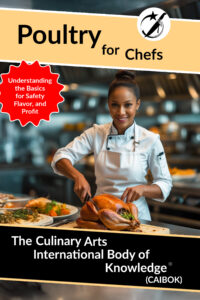CAIBOK 3215 Poultry

CAIBOK 3215 is a competency exam that evaluates a chef’s ability to work with poultry in a professional kitchen. It covers everything from selecting and storing poultry to breaking it down, cooking it with proper techniques, and serving it safely and profitably. The exam follows the CAIBOK poultry training guide and is meant for chefs, line cooks, and culinary professionals working in restaurant service.
The exam tests knowledge of poultry anatomy, cooking methods, food safety, cost control, and cultural traditions. Candidates must show they can handle poultry products with skill, care, and attention to detail.
What the Exam Covers
The 3215 Poultry Competency Exam assesses chefs on their understanding of poultry in culinary practice, with a strong emphasis on safety, global traditions, cooking methods, and business applications. The exam covers both theoretical knowledge and practical skills needed in modern kitchens. Below are the top-level sections from the official outline, each followed by a brief summary of its focus.
-
3215.0100 Poultry in History and Culture
Explores the cultural, religious, and symbolic importance of poultry throughout history. Covers ancient practices, ceremonial use, national pride, folklore, and modern trends. -
3215.0200 Poultry Fundamentals
Introduces the role of poultry in global cuisines, types and parts of poultry, and safety in handling and cooking. Emphasizes poultry’s culinary versatility and risk factors. -
3215.0300 Poultry Types and Classification
Details the classification systems for poultry, differences between wild and farm-raised birds, common cuts, religious standards, grading labels, and how to choose poultry for different dishes. -
3215.0400 Poultry Anatomy and Butchery
Covers the structure of poultry, identification of parts, knife safety, basic butchery techniques, and storage. Includes tips for efficient work and making value-added cuts. -
3215.0500 Advanced Cooking Methods for Poultry
Examines modern techniques like sous vide, smoking, braising, and steaming. Emphasizes combining methods to optimize flavor, texture, and efficiency. -
3215.0600 Global Poultry Dishes
Showcases poultry recipes and cooking methods from Asia, Europe, the Americas, and Africa. Encourages creative adaptations and cross-cultural presentations. -
3215.0700 Waste Reduction & Utilization
Teaches how to use every part of the bird—bones, offal, fat, and skin—to reduce waste and save costs. Focuses on sustainability and maximizing kitchen output. -
3215.0800 Quality Control & Safety
Provides instruction on inspecting poultry, implementing HACCP, portion consistency, and audit preparedness. Essential for food safety and compliance. -
3215.0900 Poultry Breakdown for High-Volume Kitchens
Designed for institutional kitchens. Covers speed butchery, workflow, equipment use, yield management, and team coordination. -
3215.1000 Poultry Holding & Reheating Science
Discusses techniques and tools for maintaining poultry quality after cooking, safe reheating, and minimizing food waste through moisture control. -
3215.1100 Poultry in the Culinary Business
Focuses on the business side: purchasing, pricing, inventory, trends, marketing, food safety laws, and career paths involving poultry expertise. -
3215.1200 Poultry and Dietary Trends
Addresses consumer preferences like health-focused, flexitarian, and sustainable eating. Covers labeling, special diets, and emerging food movements. -
3215.1300 Poultry Ethics, Sustainability & Regulations
Reviews ethical farming, environmental impact, global regulations, certifications, and how chefs can support sustainability in sourcing and kitchen practices. -
3215.1400 Poultry Technology and Innovation
Explores new tools and systems in poultry farming, processing, cooking, and kitchen management. Includes digital apps, robotics, and future trends. -
3215.1500 Poultry Recipes and Applications
Puts learning into practice with core and regional recipes, menu planning, recipe scaling, and strategies to reduce waste while maintaining food quality.
Passing the CAIBOK 3215 exam shows that a chef can work with poultry safely, skillfully, and profitably in a restaurant setting. It proves a high level of technical knowledge and readiness to meet industry standards.
